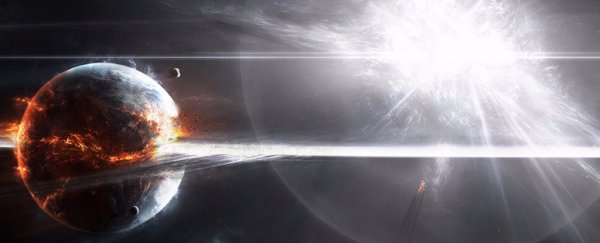A little under 3 million years ago, a massive star exploded in our galaxy about 300 light-years away. This supernova was so close to our planet that, depending on where it went off, our evolutionary ancestors might have seen it as a bright light in the sky.
As our Solar System travelled through radioactive specks of stardust left over from the explosion, some of the dust broke through our atmosphere and rained down on our planet.
Now a recent find from deep within our still-vast ocean is helping us piece together details of a cosmic event that may have changed our planet millions of years ago.
In 2004, scientists found some of this supernova debris in oceanic crust from the Pacific Ocean. But until now, scientists had a tough time pin-pointing exactly how long ago the supernova ejected its insides into space.
That's because the type of ocean crust they found the debris in grows extremely slowly – about 1 millimetre every million years.
In a new study published today in the Proceedings of the National Academy of Sciences (PNAS), scientists were able to figure out how long ago the star exploded and how much time our Solar System spent travelling through its stellar guts.
Not only was the length of time our Solar System spent in the star's remains surprising, it also coincides with an extinction event in Earth's oceans, as well as a period of global cooling.
To get these results, the scientists used a different type of ocean sediment from the Pacific Ocean that grows at a rate of 10-20 meters every million years. They were searching for atoms of a radioactive isotope of iron called iron-60.
Iron-60 is not produced on Earth, and can only be produced in these massive, exploding stars. In fact, this supernova debris is the first place in the history of our species that we've even seen it.
So what was it that preserved this 2.6 million-year-old radioactive isotope?
According to Shawn Bishop, a physicist at the Technical University of Munich in Germany and coauthor of the study, it's all thanks to a family of bacteria that lives in the ocean sediments. These bacteria grow dozens of tiny crystals of magnetite, composed of iron and oxygen, in their cells.
These crystals, Bishop said, are actually tiny bar magnets. They get their iron from nano-sized rust particles falling into the surface of the ocean from our atmosphere.
Although the bacteria are long dead and their cells have since been dissolved, the crystals, called magnetofossils because they're magnetic, remain.
Much of the supernova material coming into our atmosphere would have been a fine radioactive dust, which would have oxidised and turned to rust-like particles as it rained down on the ocean and settled into the sediments.
"The idea that stardust is found on our planet in crystals of magnetite made by bacteria that live in the ocean sediment is to my mind extremely cool," Bishop told Business Insider.
Using a technique that allowed them to count the atoms of iron-60 in the crystals, the scientists were able to figure out that the supernova went off about 2.6 million years ago, and our Solar System twirled through its guts for 800,000 years.
This was surprising to the scientists because when a supernova explodes, the material, or ejecta, that escapes the gravitational well of the star travels between about 3,000 and 6,000 miles per second (4,828 and 9,656 km/s). And yet somehow it took nearly a million years to pass through our Solar System.
"There's a mystery there," Bishop said. "Can the ejecta from a supernova explosion be spread out in time? This is something that needs to be explained and understood."
One interesting aspect about this result is that the time our planet spent inside the supernova material coincides with well-established extinction in Earth's oceans of things like marine mollusks, snails, as well as a period of global cooling.
"Our Universe is not a friendly place to live," Bishop said. "We think it is, but as soon as you leave the confines of our planet, the Universe is extremely hostile to life. There are explosions going on everywhere and if this one had been within [30 light-years] or less, we might not be here discussing it."
This article was originally published by Business Insider.
More from Business Insider:
